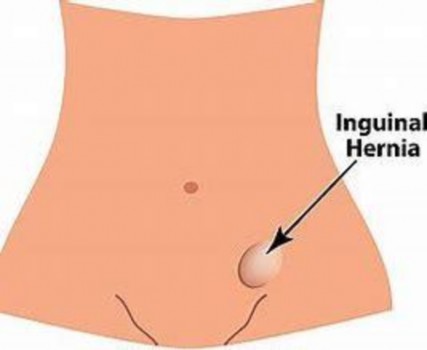Inguinal hernia
Inguinal hernias occur in up to 10 percent of males but are much less common in females. The most serious complication of groin hernias is strangulation. This occurs when a segment of the bowel is caught in the hernia and becomes obstructed or even gangrenous – medical attention must be sought immediately. Hernias never cure themselves and almost always require surgery for repair.
What is an inguinal hernia?
An inguinal hernia happens when there is a weakness in the muscles in the lower part of the abdomen, and some of the contents of the abdomen are pushed through this opening into the groin.
What causes an inguinal hernia?
There are two main types of inguinal hernias, each with different causes.
Indirect inguinal hernias usually happen because of congenital (from birth) opening in the lower abdominal muscles. This opening usually closes before birth; if it doesn’t, it can cause abdominal contents to protrude through the hole.
Direct inguinal hernias usually result from weakening of the abdominal muscles over time.
Excessive straining can also increase the chance of a direct inguinal hernia (for example, straining on the toilet or frequent coughing).
Both types of hernia are more common in males. What are the symptoms of an inguinal hernia?
You may first notice an inguinal hernia as a lump in the groin. The lump is usually painless, but some people report discomfort or a ‘dragging’ sensation. The lump may be more noticeable when you cough or strain, and usually disappears when you relax or lie down.
How will I be treated for inguinal hernia?
Most people will be advised to have surgery to fix the hernia, as this reduces the chance of developing complications.
Can I prevent an inguinal hernia?
Inguinal hernias present from birth (congenital) are not preventable.
Adults are less likely to have an inguinal hernia if they are at a healthy weight and don’t smoke and regularly eating high fibre foods to avoid constipation.
What are the complications of an inguinal hernia?
The main complication of an inguinal hernia is if it becomes strangulated. This happens when the bowel loop contained in the hernia becomes stuck outside the muscle wall, cutting off its blood supply. This is a medical emergency.
Laparoscopic inguinal hernia repair What does the operation involve?
Operation for inguinal hernia can be either by open technique or by key hole (also known as Laparoscopic repair). It is usually repaired with a synthetic mesh to reinforce your weak
Keyhole repair: Your surgeon will make a small cut on or near your belly button so they can insert an instrument in your abdominal cavity to inflate it with gas (carbon dioxide). They will make two small cuts on your abdomen so they can insert tubes (ports) into your abdomen. Your surgeon will insert surgical instruments through the ports along with a telescope so they can see inside your abdomen and perform the operation.
Your surgeon will return the part of your abdomen that is causing the hernia, and insert a synthetic mesh to cover the weak spot.
How soon will I recover?
You should be able to go home the same day or the day after.
You may return to normal activities when you feel comfortable to do so, usually after a week.
Do not play sports or do strenuous exercise for 6 weeks.
Regular exercise should help you to return to normal activities as soon as possible. Before you start exercising, ask the healthcare team or your GP for advice.
Most people make a full recovery and can return to normal activities.
The hernia can come back many years later and you may need another operation.
Benefits of keyhole surgery
- Quicker Recovery
- The small incisions result in less pain and earlier return to work, especially when hernias are present on both sides.



